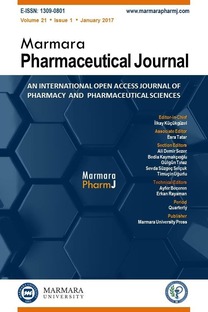Quantum-chemical calculation of the free energy of binding of vinpocetine molecules with surface of silicon and silicon dioxide
___
[1] Duncan R, Vicent MJ, Greco F, Nicholson R. Polymer-drug conjugates: towards a novel approach for the treatment of endrocine-related cancer. Endocr Relat Cancer. 2005; 12(1): 189-199.[2] Denisse Rocha-García, Antonio Guerra-Contreras, Sergio Rosales-Mendoza, Gabriela Palestino. Role of porous silicon/hydrogel composites on drug delivery. Mesoporous Biomater. 2016; 3: 93–101.
[3] Canham L. Handbook of Porous Silicon. Springer. New York, 2014, pp.156-160.
[4] Bisia O, Ossicinib Stefano, Pavesi L. Porous silicon: a quantum sponge structure for silicon based optoelectronics. Surf Sci Rep. 2000: 38(1-3), 1-126.
[5] Vivero-Escoto JL, Slowing II, Trewyn BG, Lin VSY. Mesoporous silica nanoparticles for intracellular controlled drug delivery. Small. 2010; 6(18): 1952-1967.
[6] Bobyl A, Konnikov S, Sakseev D, Soldatenkov F, Tereschenko G, Ulin V. Porous-semiconductor-based hydrogenpermeable membrane. Ind Eng Chem Res. 2007; 46(8): 2263-2267.
[7] Jarvis KL, Barnes TJ, Prestidge CA. Surface chemistry of porous silicon and implications for drug encapsulation and delivery applications. Adv Colloid Interface Sci. 2012; 175: 25-38.
[8] Golob S, Perry M, Lusi M, Chierotti MR, Grabnar I, Lassiani L, Voinovich D, Zaworotko MJ. Improving biopharmaceutical properties of vinpocetine through cocrystallization. J Pharm Sci. 2016; 105(12): 3626 - 3633.
[9] Arruebo M. Drug delivery from structured porous inorganic materials. WIREs Nanomed Nanobiotechnol. 2012; 4(1): 16-21.
[10] Wu EC, Andrew JS, Cheng L, Freeman WR, Pearson L, Sailor MJ. Real-time monitoring of sustained drug release using the optical properties of porous silicon photonic crystal particles. Biomaterials. 2011; 32(7): 1957-1966.
[11] Ding J, Li J, Shirui Mao. Development and evaluation of vinpocetine inclusion complex for brain targeting. Asian J Pharm Sci. 2015; 10(2): 114–120.
[12] Pochert А, Schneider D, Haase J, Linden M, Valiullin R. Diffusion and molecular exchange in hollow core–shell silica nanoparticles. Langmuir. 2015; 31(37): 10285 -10295.
[13] Polkovnikova YA, Lenshin AS, Seredin PV, Minakov DA. Porous silicon nanoparticles containing neurotropic drugs. Inorg Mater. 2017; 53(5): 477-483.
[14] Polkovnikova YA, Lenshin AS, Seredin PV. Studies on the development of nanoparticles with afobazole on the basis of porous silicon. Russ J Biopharm. 2017; 9(2): 43-47.
[15] Berendsen HJC, Postma JPM, Gunsteren WF, DiNola A, Haak JR. Molecular dynamics with coupling to an external bath. J Chem Phys. 1984; 81(8): 3684–3690.
[16] Bykov D, Petrenko T, Izsák R, Kossman S, Becker U, Neese F. Efficient implementation of the analytic second derivatives of hartree-fock and hybrid dft energies: a detailed analysis of different approximations. Mol Phys. 2015; 113(13): 1961-1987.
[17] Greiner M, Sonnleitner B, Mailänder M, Briesen H. Modeling complex and multi-component food systems in molecular dynamics simulations on the example of chocolate conching. Food Funct. 2014; 5(2): 235-242.
[18] Feller SE. Molecular dynamics simulations of lipid bilayers. Curr Opin Collolid Interface Sci 2000; 5(3): 217-223.
[19] Leo D, Maranon J. Confined water/oil interface. Molecular dynamics study. J Mol Struct (Theochem). 2004; 672(1-3): 221-229.
[20] Sedghi M, Piri M, Goual L. Atomistic molecular dynamics simulations of crude oil/brine displacement in calcite mesopores. Langmuir. 2016; 32(14): 3375–3384.
[21] Arivazhagana M, Manivela S, Jeyavijayanb S. Vibrational spectroscopic (FTIR and FT-Raman), first-order hyperpolarizablity, HOMO, LUMO, NBO, Mulliken charge analyses of 2-ethylimidazole based on Hartree–Fock and DFT calculations. Spectrochim Acta A. 2015; 134: 493–501.
[22] Ramakrishnan SK, Estephan E, Martin M, Cloitre T, Gergely C. Molecular Mechanism of Selective Binding of Peptides to Silicon Surface. J Chem Inf Model. 2014; 54(7): 2117−2126.
[23] Emami FS, Puddu V, Berry R, Heinz H. Force field and a surface model database for silica to simulate interfacial properties in atomic resolution. Chem Mater. 2014; 26(8): 2647−2658.
[24] Cornell WD, Cieplak P, Bayly CI, Gould IR, Merz KM, Ferguson DM, Spellmeyer DC, Fox T, Caldwell JW, Kollman PA. A second generation force field for the simulation of proteins, nucleic acids, and organic molecules. J Am Chem Soc. 1995; 117(19): 5179–5197.
- ISSN: 1309-0801
- Yayın Aralığı: 6
- Başlangıç: 1985
- Yayıncı: Marmara Üniversitesi
Ebru TÜRKÖZ ACAR, Sinem HELVACIOĞLU, Mohammad CHAREHSAZ, Ahmet AYDIN
Evren Homan GÖKÇE, Mustafa Sinan KAYNAK, Aysu YURDASİPER, Neslihan ÜSTÜNDAĞ-OKUR
Synthesis and antimicrobial effects of cyclotriphosphazenes containing monocarbonyl curcumin analogs
Mine GÜL ŞEKER, Tuğçe AKBAL, Devrim ATİLLA, Neslihan AVŞAR, Hanife İBİŞOĞLU
Formulation optimization and evaluation of Cefdinir nanosuspension using 23 Factorial design
Omkar A. PATIL, Indrajeet S. PATIL, Rahul U. MANE, Dheeraj S.RANDIVE, Mangesh A. BHUTKAR, Somnath D. BHINGE
Gopikrishna YENDURI, Srinivasu NAVULURI
Development and validation of a GC-FID method for determination of cocaine in illicit drug samples
Sankar VEINTRAMUTHU, Antony JUSTIN, Hosseiny Matin PAYMAN, Nattam SAI CHARAN KUMAR, Rajasekaran SENTHIL KUMAR
Ahmet HAŞİMOĞLU, Shantanu B. GHODKE
Muhammed İhsan HAN, Hatice BEKÇİ, Ahmet CUMAOĞLU, Ş. Güniz KÜÇÜKGÜZEL
Synthesis and evaluation of new benzoxazole derivatives as potential antiglioma agents
MEHLİKA DİLEK ALTINTOP, Gülşen AKALIN ÇİFTÇİ, Halide TEMEL EDİP
